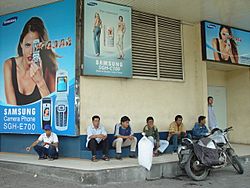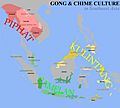Cultural geography facts for kids
Cultural geography is a sub-field within human geography. Cultural geography is the study of cultural products and norms and their variations across and relations to spaces and places. It focuses on describing and analyzing the ways language, religion, economy, government and other cultural phenomena vary or remain constant, from one place to another and on explaining how humans function spatially.
Areas of study

The areas of study of cultural geography are very broad. Among many applicable topics within the field of study are:
- Globalization has been theorised as an explanation for cultural convergence.
- Westernization or other similar processes such as modernization, americanization, islamization and others.
- Theories of cultural hegemony or cultural assimilation via cultural imperialism.
- Cultural areal differentiation, as a study of differences in way of life encompassing ideas, attitudes, languages, practices, institutions and structures of power and whole range of cultural practices in geographical areas.
- Study of cultural landscapes and cultural ecology.
- Other topics include spirit of place, colonialism, post-colonialism, internationalism, immigration, emigration and ecotourism.
Images for kids
-
A world map illustrating cultural areas.
-
Charles Booth in the 19th century produced a series of books, Life and Labour of the People in London, with various maps highlighting poverty in the city
-
Regional map of Gamelan, Kulintang, and Piphat music culture in Southeast Asia
See also
 In Spanish: Geografía cultural para niños
In Spanish: Geografía cultural para niños




